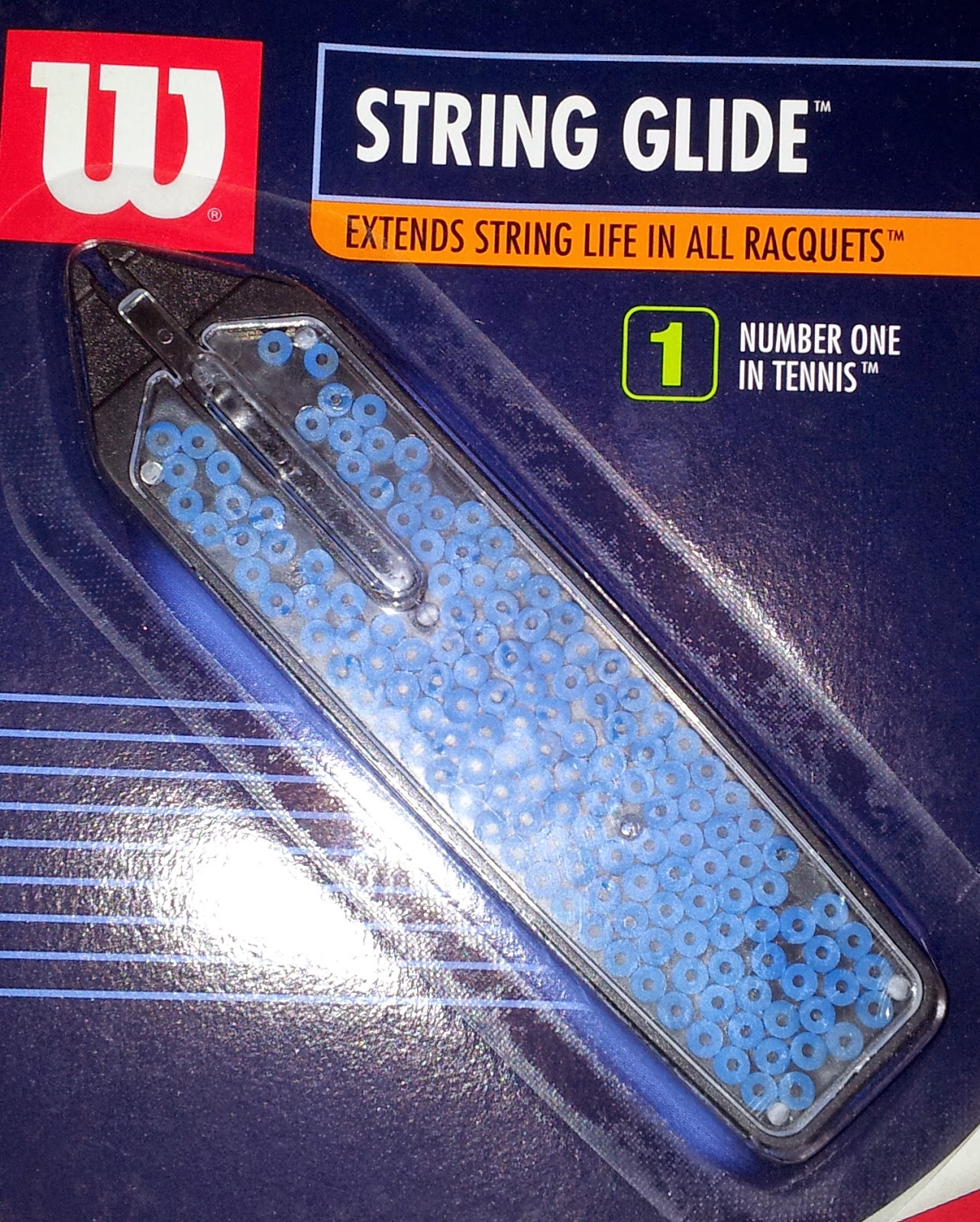Even natural gut, widely reputed to hold tension the best, loses about 13% tension. (~7 lbs stabilization loss when strung at 51 lbs, according to Tennis Warehouse University String Performance).
For non-string breakers, it can be difficult to justify cutting out a set of strings after just several hours of play.
Up till now, some of my friends call me fussy and wasteful when I cut out my strings after 8 to 10 hours. (Yet these same chaps always want to "try" my racket almost everytime we play!)
For the sake of going green, is there any easy way to "add" tension back without restringing? How can we "pull" the string and re-tension it after tie-off?
Then I came across this...
So I bought a pack and gave it a try.
The string savers look like tiny doughnuts, measuring just 3.5mm wide and about 1.5mm tall. Kind of resembles this.
The hole in the centre assists with "locking" it in place between the intersection of the mains and crosses.
Since my objective was not to "save" the strings from breakage, nor allow them to glide, that "hole" reduced the amount of string deflection I wanted.
An increase in bend means a longer string. And a longer string means greater stretch, thereby higher tension. So I cut out a few snipplets from my old replacement grip and inserted it alongside the stringsavers.
When I played with it, there was a significant increase in tautness. It felt more dampened, but the added control and power reduction was unmistakable. So much, that I moved my dampener to 12 o'clock to add about 6 swingweight points to beef up the power level.
I swapped the stringsavers and the black snipplets around and found the black pieces worked much better at "increasing" tension. None dropped off after several sessions, even at direct full impact.
When removed, the stringbed dropped back and became its former floppy trampoline again. Poor control with too much power.
For those who may be skeptical, I have measured and found that from 50 to 60 lbs of tension, both syn gut and multi stretches only an extra 1.0-1.5 mm. For poly, it's an extra 1.0 mm.
I believe either the snipplets or string savers can easily add 1.0mm of stretch to the strings. And you would need only about a dozen pieces, thereabouts.
String viagra, if I may...
This oldie was introduced sometime around 1999. According to the Tennis Warehouse review, it "quickly became Wilson's most popular selling Hyper Carbon model". (link)
This 27½" midplus version was touted to be quick, maneuverable, powerful, controlled and stable. Basically an all-rounder racket. It even served and volleyed well.
Only downside was a seemingly inability to generate spin with its 16x20 string pattern. Coupled with the very high stiffness of RA 75, I decided to use proportional stringing to soften the impact, and hopefully "turbo-charge" the spin department.
Playtest:
- The stiffness of this stick is unmistakable! Despite the softer perimeter strings, mis-hits were more uncomfortable than modern rackets.
- It could be due to the ½" longer length, but the 95 sq inch felt much smaller. Maybe more like an 90 sq inch? I was very glad proportional stringing was used to open up the sweetspot. Without which, I doubt I could handle this racket.
- Power was very good. Not excessive, but enough to land most of my shots somewhere between my opponent's service and baseline. And this power could be reigned in with shorter swings or cranked up on demand as well.
- Even with a full bed of syn gut, I found spin extremely impressive! The amount obtained easily ranks amongst the very bests I have tried. Just take a look at the amount of ball fur ripped off by the strings in half an hour.
- String movement was acceptable to me. I was not bothered by it. Rather, I found straightening them out between points comforting. You can gauge the amount of string movement in pic below.
- The extra length helped my serve. I felt I could hit the ball higher before it dropped. Placements, even near the outer side service lines felt easier. The stiff flex aided with aiming too.
- Volleys were very good. I felt confident with it. It was a matter of getting the ball on the strings and letting it do it's work.
After playing with balsa wood (link) under the overgrip for a while, a friend was lamenting the bevels felt too sharp and too hard.
He wanted something a little softer, but yet still gave him a clear feel of the bevels. Leather added too much weight, so I decided to try using cardboard instead.
The bare pallet measured 4⅛".
A single layer of cardboard added ⅛" to become 4¼".
An overgrip added another ⅛" and brought it up to his desired 4⅜".
For the butt, I used a piece of foam to provide a softer feel.
It's a very simple DIY job. Good for those who like the feel of bevels and wanted to keep the weight down.
A regular tennis partner, M, has very sensitive hands. When I have problems discerning minute differences between same model rackets, I get M to try them blind.
Within a few hits, sometimes merely "air-swings", he could tell me the difference.
But looking at how much M's pair of Yonex RD-7s bother him, I am not sure if I could call his sensitive touch a blessing.
Near the bottom left of both pics were scribbled the racket's balance. One at 32.0cm and the other 32.5cm.
Even with the same strings and same tension, this balance (0.5cm) and total weight difference (a whopping 2 grams!!!) affected M so much!
During play, I could see his swing timing difference between both rackets! His ball trajectory, drive, spin and accuracy were distinct for each. Judging from the shots that came over, I could clearly tell which stick he was using!
I am grateful I can handle some "manufacturing tolerances". Even when they were out by about 10 grams, or balance off by about 1cm, I am fine. I would feel a little uneasy switching rackets, but a couple of minutes settles me down.
It is common for many to have multiple similar rackets. If you play competitively, make sure to try them side-by-side. Play a set each with the same partner. Or rotate rackets every two games and video yourself if possible.
When swapping rackets mid-game, between me adapting to a slightly different stick (like different strings, tension or swingweight), and my opponent adjusting to different kind of shots going towards them, I usually adapt faster. (link)
Lest you wonder, M's full name is not Maradona. (link)
Despite having been around for about three decades now, many still seem to have misconceptions about poly strings.
From its infant days, poly has come a very long way. Broadly speaking, we are now in the fourth generation of poly strings.
Without referring to specific brands or models, the first generation poly string was simply slick, stiff and dead. Nothing else.
Elasticity was so low that every ball impact took some tension off through string deformation. String life was so pathetic that it was probably better monitored by the number of shots one hit, rather than by time used.
While the spin was hugely rewarding, the stiffness must have affected quite a few players. As a result, a second generation of poly was born.
Additives were added to soften the string and the term co-poly surfaced. When strung within a specific tension range, from about the mid-40s to low-50s lbs, a higher level of comfort was achieved through greater elasticity.
Within this range, tension holding also improved. However, when strung below or above, it still played as boardy and stiff as the first generation.
I believe it was from this generation of poly that caused many misconceptions about poly's useful tension range, up till today.
The third generation poly was heavily marketed with more "bite". That was when shaped co-polys came aboard. Five-sided pentagonals, hexagonals, spirals, twisted and fused, and many with rough edges became wildly popular. Comfort improved further.
The most popular fourth generation poly string now is Luxilon 4G. Aptly named, as "4G" simply refers to fourth generation. Tension holding and comfort were touted to be "uncommon for a poly".
Somewhere around the third or fourth iteration, the useful tension range widened tremendously. Many reported great results from as low as 20+ lbs (link), to as high as 90 lbs! Yes, with full poly!
Personally, I have tested quite a few between 30 to 70 lbs. Surprisingly, at either 30, or 70 lbs in the same racket, it played almost equally boardy! But the one with lower tension loosened up much more rapidly, whereas the tighter strung took about an hour to "break-in" before playing well.
I could not find much difference in the amount of spin between the four generations. Variances were only on comfort and tension holding.
Whichever generation of poly it is, keep in mind it was introduced solely to generate tons of spin. To achieve that, it has to be made very slick and very stiff to snap back effectively. Slick and soft would not work as well for spin.
As a result, poly demands a strong loading to play well. And that could mean very long loopy full swings, or rackets with high swingweights and open string patterns.
Tennis balls that are a little heavier, have high bounce and are "hard like rocks" for natural gut or synthetic gut could also possibly help with the string loading required. Just be wary of your own shoulder, elbow, arm or wrist tolerances.













